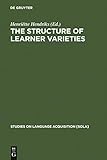The Structure of Learner Varieties / ed. by Henriëtte Hendriks.
Material type: TextSeries: Studies on Language Acquisition [SOLA] ; 28Publisher: Berlin ; Boston : De Gruyter Mouton, [2011]Copyright date: ©2005Description: 1 online resource (515 p.) : Num. figs. and tabContent type:
TextSeries: Studies on Language Acquisition [SOLA] ; 28Publisher: Berlin ; Boston : De Gruyter Mouton, [2011]Copyright date: ©2005Description: 1 online resource (515 p.) : Num. figs. and tabContent type: - 9783110184686
- 9783110909593
- 401/.93 22
- P118 .S814 2005eb
- online - DeGruyter
- Issued also in print.
| Item type | Current library | Call number | URL | Status | Notes | Barcode | |
|---|---|---|---|---|---|---|---|
 eBook
eBook
|
Biblioteca "Angelicum" Pont. Univ. S.Tommaso d'Aquino Nuvola online | online - DeGruyter (Browse shelf(Opens below)) | Online access | Not for loan (Accesso limitato) | Accesso per gli utenti autorizzati / Access for authorized users | (dgr)9783110909593 |
i-iv -- Contents -- The Structure of Learner Varieties: Introduction to the volume -- Part I: Referential movement -- Reference to persons and objects in the function of subject in Learner Varieties -- Reference to person in learner discourse -- Structuring space in discourse: A comparison of Chinese, English, French and German LI and English, French and German L2 acquisition -- Two dimensions of the representation of complex event structures: granularity and condensation. Towards a typology of textual production in LI and L2 -- Cross-linguistic analysis of temporal perspectives in text production -- Determinants in first and second language acquisition: person, space, and time in discourse across languages -- Part II: Scope -- The semantic knowledge base for the acquisition of negation and the acquisition of finiteness -- The acquisition of negation in Italian L2 -- The acquisition of negation in French L2. An analysis of Moroccan Arabic and Spanish “learner varieties” -- Additive and Restrictive Particles in Italian as a Second Language. Embedding in the verbal utterance structure -- Additive Scope Particles in Advanced Learner and Native Speaker Discourse -- Reading from outside: Acquisitional patterns in a cross-linguistic approach -- Index
restricted access online access with authorization star
http://purl.org/coar/access_right/c_16ec
This volume brings together ten contributions to the study of untutored (mainly) second but also first language acquisition. All chapters have been written from a functionalist perspective and take as the main theoretical framework a model of spontaneous second language acquisition centered on the "basic variety" as proposed by Klein and Perdue. The chapters in the volume are grouped around two research themes. The first theme concerns the acquisition of scope phenomena (negation, scope particles), the second one deals with referential movement (reference to person, time and space). Both parts provide insights in the structure of learner varieties at various stages of development, and are followed by a discussion chapter. Scope phenomena, such as negation and frequency adverbials present an important learning problem, as learners have to reconcile the logical structure of their utterances with the syntactic specifics of the language being learned. Their acquisition has been relatively neglected in studies up to date, however, and we even lack detailed knowledge about the interpretation of scope particles in the target languages. The chapters in this part of the volume set out to provide more knowledge about scope phenomena in general; more detailed descriptions of the particles in the languages under consideration; and a more general understanding of how scope is acquired. Strong findings resulting from the "ESF" project suggested universal trends in how untutored learners deal with acquisition in the very early stages (the basic variety). Chapters in this second part of the volume on referential movement look at acquisition at more advanced stages, including the production of near native speakers. Learners who progress beyond the basic variety increasingly grammaticalise their productions. This later development is supposedly more variable, as more specific aspects of the target languages are now being acquired. Chapters in this part allow to shed more light on the question regarding universal and language-specific influences on language acquisition.
Issued also in print.
Mode of access: Internet via World Wide Web.
In English.
Description based on online resource; title from PDF title page (publisher's Web site, viewed 28. Feb 2023)


